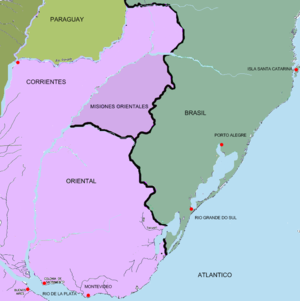
Spanish-Portuguese War, 1735-1737
Encyclopedia

Banda Oriental
The Banda Oriental del Uruguay was the South American territory east of the Uruguay River and north of the Río de la Plata, coinciding approximately with the modern nation of Uruguay, the Brazilian State of Rio Grande do Sul and some parts of Santa Catarina...
, roughly present-day Uruguay.
At that time, this part of South-America was sparsely populated and was on the border between Portuguese Colonial Brazil
Colonial Brazil
In the history of Brazil, Colonial Brazil, officially the Viceroyalty of Brazil comprises the period from 1500, with the arrival of the Portuguese, until 1815, when Brazil was elevated to kingdom alongside Portugal as the United Kingdom of Portugal, Brazil and the Algarves.During the over 300 years...
and the Spanish Governorate of the Río de la Plata.
Spain claimed the area based on the Treaty of Tordesillas
Treaty of Tordesillas
The Treaty of Tordesillas , signed at Tordesillas , , divided the newly discovered lands outside Europe between Spain and Portugal along a meridian 370 leagueswest of the Cape Verde islands...
of 1494, but Portugal had founded the first city there, the Sacramento Colony, in 1680. Spain had taken the city twice, in 1681 and in 1705, but had had to give it back to the Portuguese by the Treaty of Utrecht
Treaty of Utrecht
The Treaty of Utrecht, which established the Peace of Utrecht, comprises a series of individual peace treaties, rather than a single document, signed by the belligerents in the War of Spanish Succession, in the Dutch city of Utrecht in March and April 1713...
in 1713.
The following years saw an expansion of the Portuguese settlements around the Sacramento Colony, in a radius of up to 120 km.
As a reaction, capitán general of Río de la Plata Bruno Mauricio de Zabala
Bruno Mauricio de Zabala
Bruno Mauricio de Zabala was a Spanish soldier and colonial administrator. He was born in the slum of Zabala in the province of Biscay...
had founded Montevideo
Montevideo
Montevideo is the largest city, the capital, and the chief port of Uruguay. The settlement was established in 1726 by Bruno Mauricio de Zabala, as a strategic move amidst a Spanish-Portuguese dispute over the platine region, and as a counter to the Portuguese colony at Colonia del Sacramento...
on December 24, 1726 to prevent further expansion. But the Portuguese trade made the Spanish suffer, as they were still compelled to trade with Spain over the Viceroyalty of Peru
Viceroyalty of Peru
Created in 1542, the Viceroyalty of Peru was a Spanish colonial administrative district that originally contained most of Spanish-ruled South America, governed from the capital of Lima...
, who imposed heavy taxes. Spain considered the Portuguese presence illegitimate and their trade contraband.
In March 1734, the new capitán general of Río de la Plata, Miguel de Salcedo y Sierraalta, received orders from Madrid to reduce the action radius of the Sacramento Colony to "a gunshot", say two kilometers. He sent an ultimatum to António Pedro de Vasconcelos, the Portuguese governor of the colony, who stalled for time.
In 1735 tensions raised between Spain and Portugal and Spanish ships under Alzaybar captured several Portuguese vessels. On April 19, Prime minister José Patiño
José Patiño
Don José Patiño , Spanish statesman, was born at Milan.His father, Don Lucas Patino de Ibarra, Señor de Castelar, who was by origin a Galician, was a member of the privy council and inspector of the troops in the Duchy of Milan for the king of Spain, to whom it then, belonged...
ordered Salcedo to attack Sacramento.
Salcedo gathered 1500 men and marched slowly on Sacramento, wasting a lot of time attacking minor targets along the road. He was supported by 4000 Indian warriors who came from the Jesuit Reductions
Jesuit Reductions
A Jesuit Reduction was a type of settlement for indigenous people in Latin America created by the Jesuit Order during the 17th and 18th centuries. In general, the strategy of the Spanish Empire was to gather native populations into centers called Indian Reductions , in order to Christianize, tax,...
. The siege started on October 14, 1735.
By that time Vasconcelos had prepared the defense and sent a messenger to Rio de Janeiro
Rio de Janeiro
Rio de Janeiro , commonly referred to simply as Rio, is the capital city of the State of Rio de Janeiro, the second largest city of Brazil, and the third largest metropolitan area and agglomeration in South America, boasting approximately 6.3 million people within the city proper, making it the 6th...
to ask for reinforcements. José da Silva Pais
José da Silva Pais
José da Silva Pais was a Portuguese soldier and colony administrator.He was involved in diverse situations in the disputed territories between the Portuguese and Spanish in the territory that today is the South region in Brazil...
send six Portuguese ships, which arrived on January 6 followed by 12 more ships a few days later. The Spanish had tried to impose a naval blockade, but the Portuguese had more ships and gained naval superiority.
In 1736 and 1737 more ships were sent from Spain and Portugal and an occasional confrontation between a few ships occurred. But Spain couldn't gain the upper hand and on September 6 1736, the Portuguese even lay siege to Montevideo, but withdrew when Salcedo sent a relief force of 200 men.
On March 16, 1737 under influence of France, Great Britain and the Netherlands, a treaty was signed. In September the siege was lifted and the Spanish withdrew their forces and Miguel de Salcedo was disposed as governor of Buenos Aires.
The war was local and involved only a couple of thousand men on each side.

